Saanich group says it may have the numbers to stall operations centre AAP
The group of Saanich residents says it delivered 8,276 hard-copy electoral response forms (ERFs) to Saanich Municipal Hall on Wednesday, the final day to vote to reject Saanich’s ask to borrow $150M for the project.
Saanich Municipal Hall. Photo: Capital Daily
As Saanich begins to count ballots opposing its alternative approval process (AAP) for a new operations centre, a group leading its opposition appears confident there will be enough votes to reject the proposal.
“We’re very optimistic,” Nancy Di Castri, president of Save Our Saanich Neighbourhoods Society, tells Capital Daily.
The group of Saanich residents says it delivered 8,276 hard-copy electoral response forms (ERFs) to Saanich Municipal Hall on Wednesday, the final day to vote to reject Saanich’s ask to borrow $150M for the project.
Under provincial rules for an AAP, only 10% of the populace must officially oppose it, or it passes.
In Saanich’s case, 8,735 no votes would have to be received, meaning if the Save Our Saanich count is accurate, 459 are now needed to sidetrack the AAP.
That would leave the municipality to decide whether to hold a referendum or put the idea aside.
“Should the AAP fail, Saanich Council would need to work with staff to identify next steps,” said a spokesperson for Mayor Dean Murdock, who told Capital Daily the mayor wouldn’t comment until the AAP outcome is known.
The district’s corporate officer is now counting and certifying the ERFs, and the results will be announced during an upcoming council meeting, Saanich said in a release.
Stay connected to your city with the Capital Daily newsletter.
By filling out the form above, you agree to receive emails from Capital Daily. You can unsubscribe at any time.
Di Castri says her group isn’t against the idea of building a new ops centre to replace the 60-year-old facility at 1040 McKenzie. It just doesn’t feel the AAP process is democratic.
“Because nobody knows about it. It's like negative billing,” she says, referring to the practice where a consumer gets charged for a service or product without their explicit consent. The federal government banned negative billing in 1996.
“First of all, they have to know about it, which was a big hurdle,” Di Castri says. And then they have to go to the trouble to download the ballot, either email it in, or, you know, print it, sign it, and take it into Saanich,” Di Castri says. “So you know, it's, it's a somewhat cumbersome process.”
Antithetically, an AAP’s support is registered through silence.
Saanich says it made this known
Saanich says the AAP “was extensively communicated through various channels, including local newspapers, social media, email newsletters, community association notices, and at public events, in addition to information posted on saanich.ca.”
The district says AAPs are cost-effective, efficient ways to gauge support and gain public consent to borrow money, while a referendum can delay construction and increase costs.
“In the case of the SOC Redevelopment Project, a delay of even a year could result in the project cost increasing by more than $17M,” the spokesperson said in an email to Capital Daily.
Different, but not undemocratic, says Royal Roads prof
David Black, an associate professor of communications and culture at Royal Roads University, told the Times Colonist the AAP may not be popular, but it doesn’t defy democracy.
“It’s differently democratic. It’s not as democratic as a referendum, but it is not insignificant, and it reflects the reality of municipal politics,” he said. “You can’t have a referendum on every big decision, or you just exhaust the public.”
Di Castri agrees that a referendum is more reflective of a community’s wishes, and she says the district could save the $300K cost of conducting one by putting the question on the ballot—and asking voters to decide on the operations centre when they vote in next year’s municipal elections.
“What our concern was,” Di Castri says, “if this is successful, is this going to be the way going forward?”
BC raises the amount municipalities can leverage
Earlier this week, the province increased the amount of money municipalities can borrow without calling a referendum or AAP by doubling the borrowing limit to 10% from 5% of general revenue.
Municipalities, which by law are not allowed to go into debt, would still need public consent to pursue major projects but would be able to more easily pursue more smaller projects.
“There’s no money for any of this,” says DiCastri, who predicts the municipalities and those who run them will pay the price.
“The people are becoming angry with their mayors and their councils,” she says. “Building is happening too quickly. We can't support this building.”
Saanich says it needs the new facility
The municipality argues that replacing the district’s nerve centre, where transportation, water, solid waste, and parks services are carried out, is a must, not a want.
“More than 300 staff are working in substandard facilities more than 60 years old; the age and condition of these facilities pose unnecessary risk to our service delivery,” the district says in a Saanich Operations Centre FAQ.
It says Saanich’s population has shot up 50% since the facilities were built.
“This puts increased pressure on the facility, the site infrastructure, and staff. Looking to the future, these pressures are unsustainable, and action should be taken to address them.”
Should the No side fail to reach the 10% threshold and the APP pass, Saanich homeowners would face a 0.85% tax increase in each of the next four years. In addition, each homeowner would pay $3.60 more each year for four years for water, $4.00 more per year for the next four years for sewer utilities, and $1.70 more each year for four years for solid waste services.
Commercial property tax rates will be impacted in the same way as residential property tax, the district said.
Stay connected to your city with the Capital Daily newsletter.
By filling out the form above, you agree to receive emails from Capital Daily. You can unsubscribe at any time.






.jpg)









